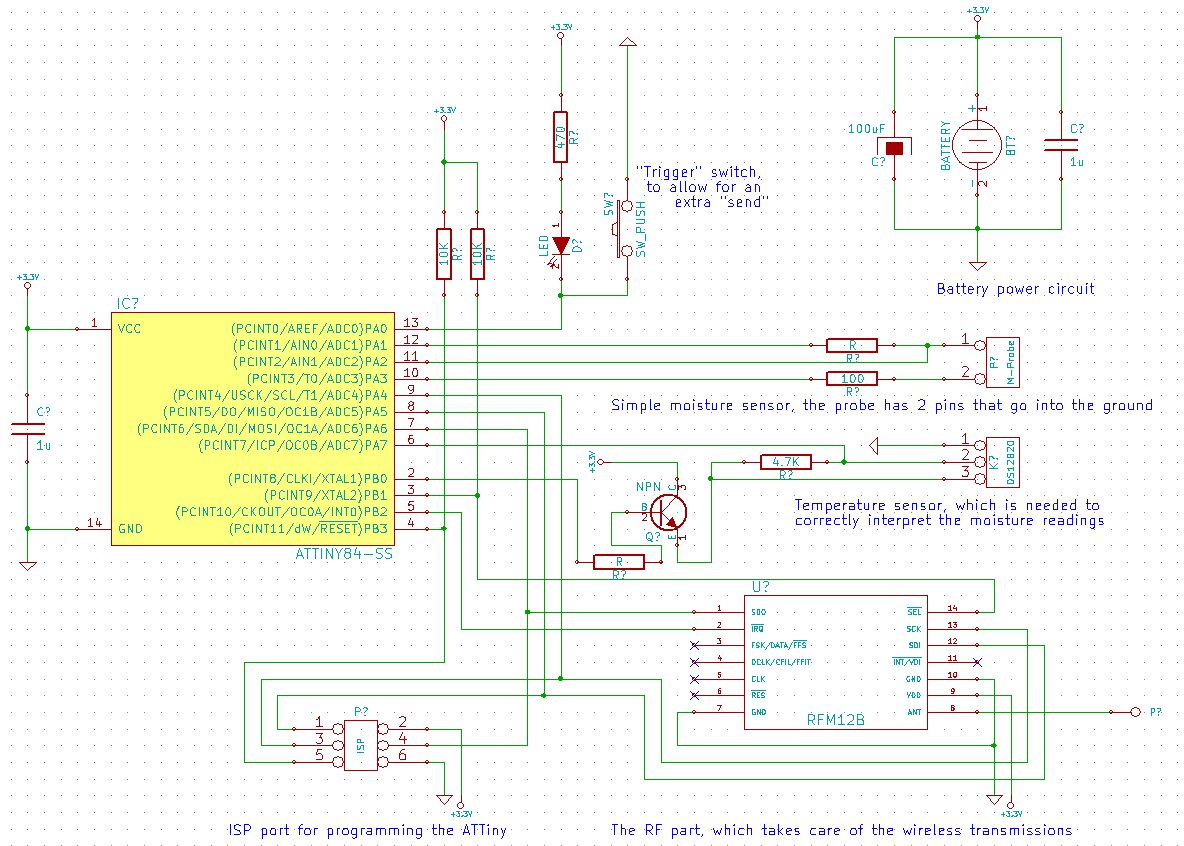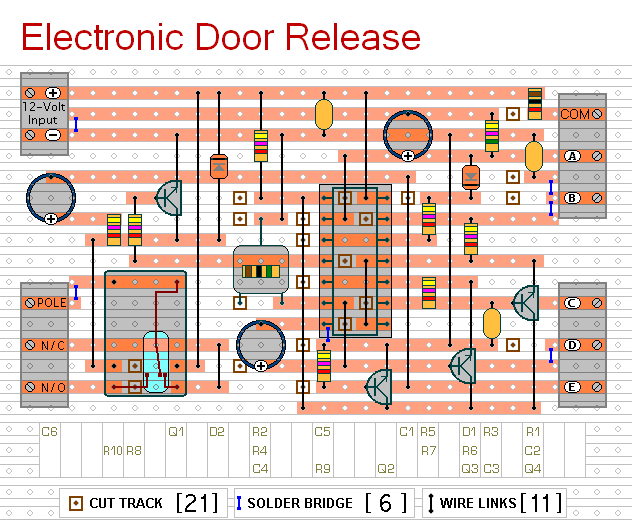
Bicycle alarm electronic project

This project was undertaken in June 1996 as a final year electronics project. The circuit was constructed using individual components, including logic gate integrated circuits (ICs) and a keyboard decoder IC. Since then, electronics has advanced, and if created today, most functionality would likely be implemented using a microprocessor or microcontroller, such as the Arduino prototyping board. However, this serves as an example of circuit design using logic components. To set the alarm, the power supply must be disconnected, which is accomplished using a transistor switch that disconnects the supply when the full or part set switch is pressed. This is managed by a NOR gate (IC2D), an 18-pin IC that utilizes a matrix output type keypad. The PIN number can be programmed directly from the keypad, simplifying the programming process. The IC is CMOS compatible and features a key-in echo, which emits a beep each time a key is pressed. The circuit would need to be relatively complex to utilize this IC effectively. The circuit diagram provided illustrates the IC's application as a door opener. The choice of decoder was influenced by two primary factors: the complexity required for the subsequent circuit and cost considerations. The RS7225 provides fixed output levels, allowing direct driving of combination logic, whereas the UA3730 necessitates specialized sequential logic to decode outputs. Although the costs of both ICs are comparable, the telephone-type keypad associated with the RS7225 is significantly cheaper, and a membrane keypad option offers additional waterproofing. As the RS7225 requires power disconnection to reset outputs, a transistor switch is implemented to disconnect the supply and reset the alarm, triggered by IC2D, which is linked to the part set and full set selections that control TR1. The alarm set indicator is sourced from pin 8 on IC1. To deter potential intruders, an LED is designed to flash at a constant speed, as a flashing light is more conspicuous than a steady one. This can be achieved using either a 555 timer or an alternative astable circuit to switch the LED on and off. The enable input is derived from pin 8 on IC1, controlling the astable circuit. In the off state, current consumption remains low, while in the flashing state, it is still lower than that of a 555 timer. The frequency is determined by the product of capacitance and resistance. This circuit requires only half of a quad 2-input NOR IC, one resistor, one capacitor, and one transistor (with an additional resistor for LED current limiting). It is crucial for the NOR gates to have buffered outputs; however, most CMOS ICs are buffered, making this a non-critical factor. The time constant is set to 0.3 seconds, resulting in a frequency of approximately 3 Hz, which is adequate for visibility without being too rapid. This time constant is achieved using a 100nF capacitor and a 3.3M resistor, selected from the nearest standard values, resulting in a satisfactory flashing rate during testing on a breadboard. The method for selecting part or full set mode is designed to protect night lights when installed and to prevent false triggering when they are not. To activate the alarm (either part or full), IC2D is utilized to trigger TR1, disconnecting power from the IC. This has been previously mentioned in the context of the PIN decoder. The selection between set or part set mode is managed by an RS flip-flop, which can be implemented through two methods. One approach involves using an RS flip-flop IC, which is costly and bulky as it contains four flip-flops in a single package. The alternative is to construct the flip-flop using discrete components, which can be more space-efficient and cost-effective.
The circuit design incorporates a series of logic gates and components to create a functional alarm system. The use of a NOR gate as a core component allows for the implementation of both the alarm setting mechanism and the LED alert system. The transistor switch plays a critical role in controlling the power supply to the alarm system, ensuring that the alarm can be reset effectively. The keypad interface simplifies user interaction, while the choice of components balances functionality with cost-effectiveness. The flashing LED serves both as a deterrent and as an indicator of the alarm's status, enhancing the overall effectiveness of the security system. The design reflects a thoughtful consideration of user needs and technological constraints of the time, demonstrating an understanding of fundamental electronics principles.This is a project that I undertook during June 1996 as my final year electronics project. The entire circuit was built using individual components including logic gate ICs and and keyboard decoder IC. Since them electronics has moved on and if this was created today most of the functionality would instead be implemented using a microprocessor / mi
crcontroller such as the Arduino prototyping board. This is however an example of how circuits can be designed using logic components. To set the alarm the supply must be disconnected. To achieve this a transistor switch is used to disconnect the supply when the full or part set switch is pressed. This is achieved using a NOR gate (IC2D). This is a 18 pin IC which uses a matrix output type keypad. The PIN number can be separately programmed directly from the keypad. This makes programming much easier. The pin layout is shown below. The IC is CMOS compatible and has a key-in echo, which bleeps every time a key is pressed. The following circuit would have to be fairly complex to use this IC. Below is the circuit diagram if the IC was for use as a door opener. The choice of the decoder was based on two main factors. The first was the required complexity of the following circuit. As the RS7225 gave fixed output levels the IC could drive combination logic directly whereas the UA3730 would require special sequential logic to decode the outputs.
The second factor was cost. The cost of the two ICs is very much the same but the cost of the required keypad was much cheaper for the telephone type keypad. Also a membrane keypad was available for the telephone type which gave a level of waterproofing. As the RS7225 required the disconnection of the supply to reset the outputs a transistor switch has been used to disconnect the supply and reset the alarm.
This is triggered by IC2D which is connected to the part set and the full set selections which switches TR1. The alarm set indicator is taken from pin 8 on IC1. As a warning to potential thiefs the LED was to flash on and off at a constant speed. This alerts the thief better than a constant light as a flashing light is much more obvious and more noticeable.
This could be achieved by using 2 methods, a 555 counter or a different astable firing a transistor hence switching the LED on and off. The enable input would come from pin 8 on IC1 which would switch the astable on and off. When in the off state then the current consumed would be very low. When in the flashing state the current consumption would still be lower than the 555s. The frequency is equal to the multiple of the capacitance and the resistance. This circuit only requires ½ a (Quad 2 input) NOR IC, 1 resistor, 1 capacitor, and 1 transistor (the other resistor is for current limiting the LED and would be required anyway.
It is very important that the NOR gates have buffered outputs, but most CMOS ICs are buffered anyway and so this is not a deciding factor. The time constant used is a 0. 3 seconds giving a frequency of about 3 Hz. This is slow enough to be seen but fast enough so as it can be seen within a short time period. This time constant was given by using a 100nF capacitor and a 3. 3M resistor. These were the nearest standard values. This gave a reasonable flashing rate when tested on breadboard. This is the method in which part or full set mode is selected. As mentioned earlier this is to allow protection of the night lights when they are fitted and to prevent incorrect triggering if they are not fitted.
To set the alarm (regardless of part or full) IC2D was used to trigger TR1 and disconnect power from the IC. This is mentioned earlier under the PIN decoder section. The decision for set or part set is selected by means of an RS flip-flop. The flip-flop could have been obtained by two methods. One method is to use a RS flip-flop IC this method is expensive and bulky as the IC packages contain 4 flip-flops.
The other a 🔗 External reference
The circuit design incorporates a series of logic gates and components to create a functional alarm system. The use of a NOR gate as a core component allows for the implementation of both the alarm setting mechanism and the LED alert system. The transistor switch plays a critical role in controlling the power supply to the alarm system, ensuring that the alarm can be reset effectively. The keypad interface simplifies user interaction, while the choice of components balances functionality with cost-effectiveness. The flashing LED serves both as a deterrent and as an indicator of the alarm's status, enhancing the overall effectiveness of the security system. The design reflects a thoughtful consideration of user needs and technological constraints of the time, demonstrating an understanding of fundamental electronics principles.This is a project that I undertook during June 1996 as my final year electronics project. The entire circuit was built using individual components including logic gate ICs and and keyboard decoder IC. Since them electronics has moved on and if this was created today most of the functionality would instead be implemented using a microprocessor / mi
crcontroller such as the Arduino prototyping board. This is however an example of how circuits can be designed using logic components. To set the alarm the supply must be disconnected. To achieve this a transistor switch is used to disconnect the supply when the full or part set switch is pressed. This is achieved using a NOR gate (IC2D). This is a 18 pin IC which uses a matrix output type keypad. The PIN number can be separately programmed directly from the keypad. This makes programming much easier. The pin layout is shown below. The IC is CMOS compatible and has a key-in echo, which bleeps every time a key is pressed. The following circuit would have to be fairly complex to use this IC. Below is the circuit diagram if the IC was for use as a door opener. The choice of the decoder was based on two main factors. The first was the required complexity of the following circuit. As the RS7225 gave fixed output levels the IC could drive combination logic directly whereas the UA3730 would require special sequential logic to decode the outputs.
The second factor was cost. The cost of the two ICs is very much the same but the cost of the required keypad was much cheaper for the telephone type keypad. Also a membrane keypad was available for the telephone type which gave a level of waterproofing. As the RS7225 required the disconnection of the supply to reset the outputs a transistor switch has been used to disconnect the supply and reset the alarm.
This is triggered by IC2D which is connected to the part set and the full set selections which switches TR1. The alarm set indicator is taken from pin 8 on IC1. As a warning to potential thiefs the LED was to flash on and off at a constant speed. This alerts the thief better than a constant light as a flashing light is much more obvious and more noticeable.
This could be achieved by using 2 methods, a 555 counter or a different astable firing a transistor hence switching the LED on and off. The enable input would come from pin 8 on IC1 which would switch the astable on and off. When in the off state then the current consumed would be very low. When in the flashing state the current consumption would still be lower than the 555s. The frequency is equal to the multiple of the capacitance and the resistance. This circuit only requires ½ a (Quad 2 input) NOR IC, 1 resistor, 1 capacitor, and 1 transistor (the other resistor is for current limiting the LED and would be required anyway.
It is very important that the NOR gates have buffered outputs, but most CMOS ICs are buffered anyway and so this is not a deciding factor. The time constant used is a 0. 3 seconds giving a frequency of about 3 Hz. This is slow enough to be seen but fast enough so as it can be seen within a short time period. This time constant was given by using a 100nF capacitor and a 3. 3M resistor. These were the nearest standard values. This gave a reasonable flashing rate when tested on breadboard. This is the method in which part or full set mode is selected. As mentioned earlier this is to allow protection of the night lights when they are fitted and to prevent incorrect triggering if they are not fitted.
To set the alarm (regardless of part or full) IC2D was used to trigger TR1 and disconnect power from the IC. This is mentioned earlier under the PIN decoder section. The decision for set or part set is selected by means of an RS flip-flop. The flip-flop could have been obtained by two methods. One method is to use a RS flip-flop IC this method is expensive and bulky as the IC packages contain 4 flip-flops.
The other a 🔗 External reference





